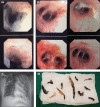Airway management in inhalation injury: a case series
- PMID: 31197372
- PMCID: PMC7900805
- DOI: 10.11622/smedj.2019048
Airway management in inhalation injury: a case series
Abstract
Inhalation injury is a serious consequence of a fire or an explosion, with potential airway compromise and respiratory complications. We present a case series of five patients with inhalational burns who presented to Singapore General Hospital and discuss our approach to their early management, including early evaluation and planning for the upper and lower airway, coexisting cutaneous burns, and monitoring their ICU (intensive care unit) severity of illness, sepsis and acute respiratory distress syndrome. All five patients suffered various grades of inhalation injury. The patients were initially assessed by nasolaryngoscopy, and three patients were prophylactically intubated before being sent to the emergency operating theatre for definitive airway and burns management with fibreoptic bronchoscopy. All patients were successfully extubated and discharged stable. Various complications can arise as a result of an inhalation injury. Based on our cases and literature review, we propose a standardised workflow for patients with inhalation injury.
Keywords: airway management; bronchoscopy; burns; inhalation injury; ventilation.
Copyright: © Singapore Medical Association.
Figures






References
-
- Gill P, Martin RV. Smoke inhalation injury. Contin Educ Anaesth Crit Care Pain. 2015;15:143–8.
Publication types
MeSH terms
LinkOut - more resources
Full Text Sources
Medical

